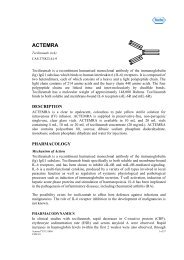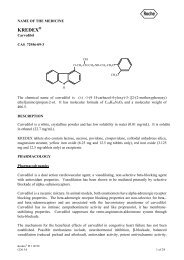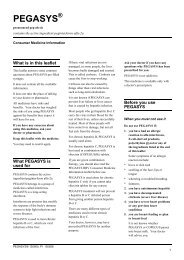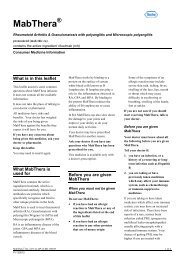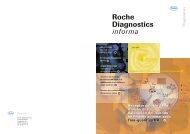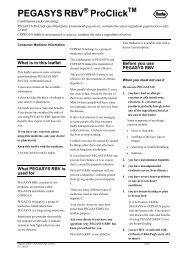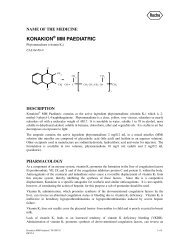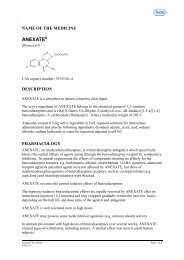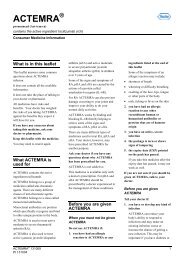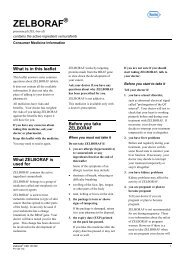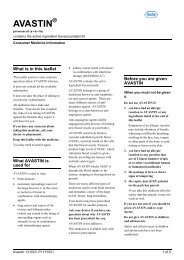Rocaltrol (calcitriol) - Product Information (PI) - Roche Australia
Rocaltrol (calcitriol) - Product Information (PI) - Roche Australia
Rocaltrol (calcitriol) - Product Information (PI) - Roche Australia
You also want an ePaper? Increase the reach of your titles
YUMPU automatically turns print PDFs into web optimized ePapers that Google loves.
R<br />
Phase II studies of ROCALTROL in post-menopausal osteoporosis were undertaken in the USA and<br />
involved a total of 93 patients. The primary endpoint was effect on vertebral fracture rates. Dose<br />
titration resulted in a mean dose of 0.5 to 0.6 microgram/day. Two studies were very similar, with an<br />
initial two month placebo treatment for all patients, followed by a ten month double-blind comparison<br />
of ROCALTROL and placebo, with a subsequent extension of 12 to 30 months during which all<br />
patients received ROCALTROL. The third study compared ROCALTROL with placebo in an initial<br />
six month single-blind evaluation, with a subsequent open phase of up to 24 months ROCALTROL<br />
treatment. Dietary calcium was supplemented to 600 mg per day in the two double-blind trials. A<br />
highly significant reduction was noted in the fracture rate in patients treated with ROCALTROL in<br />
comparison with placebo in the three double blind studies. Overall, there was a statistically significant<br />
association between ROCALTROL treatment and the suppression of fractures. Calcium absorption<br />
was significantly increased in the ROCALTROL groups in all three studies.<br />
Males with osteoporosis<br />
There are few data on the safety and efficacy of ROCALTROL on fracture rates and bone mineral<br />
density in osteoporotic men.<br />
Calcitriol versus calcium<br />
A randomised double-blind, placebo-controlled pilot trial assessed the efficacy of <strong>calcitriol</strong> 0.25<br />
micrograms twice daily versus calcium 500 mg twice daily for 24 months in men with osteoporosis.<br />
Twenty-one men were randomised to receive <strong>calcitriol</strong> and 20 to receive calcium. Due to the size of<br />
the study no valid conclusions were drawn regarding the efficacy in terms of bone mineral density<br />
(BMD) and vertebral fracture rates.<br />
Corticosteroid-induced osteoporosis<br />
A randomised, double blind, placebo and comparator-controlled trial was conducted in 103 enrolled<br />
male and female patients with rheumatic, immunological or respiratory disease. The subjects enrolled<br />
within four weeks of starting long-term corticosteroid therapy. The three treatment groups were the<br />
placebo group (n = 29, calcium 1000 mg/day), <strong>calcitriol</strong> group (n = 34, oral calcium 1000 mg/day,<br />
<strong>calcitriol</strong> 0.5 - 1 microgram/day) and the <strong>calcitriol</strong> plus calcitonin group (n = 29, oral calcium 1000<br />
mg/day, <strong>calcitriol</strong> 0.5 - 1 microgram/day, intranasal calcitonin 400 IU/day). Each treatment group<br />
received active treatment for 12 months and was followed up for a further 12 months.<br />
The primary efficacy end-point was bone mineral density measured at the lumbar spine, femoral neck<br />
and distal radius by photon absorptiometry. Serum levels of parathyroid hormone, 25-hydroxyvitamin<br />
D, 1,25-dihydroxyvitamin D and osteocalcin and urinary levels of calcium, hydroxyproline and<br />
creatinine were also measured. The bone density measurements and biochemical analyses were made<br />
at baseline and then every four months for two years. Serum calcium was measured at one, three and<br />
five weeks and every two months thereafter.<br />
After the first year both treatment groups showed a similar and statistically significant reduction in<br />
bone loss at the lumbar spine but not at the femoral neck or distal radius compared to the placebo<br />
group. In the second year, this reduction in bone loss was no longer apparent in the <strong>calcitriol</strong> group.<br />
However, this group did receive a higher cumulative dose of corticosteroids during the second year.<br />
The study medications were generally well tolerated with few adverse effects. The most frequent<br />
events were hypercalcaemia and rhinorrhoea. Hypercalcaemia was seen in one placebo group patient,<br />
<strong>Rocaltrol</strong> ® <strong>PI</strong> 111107 4 of 12<br />
CDS 3.0



